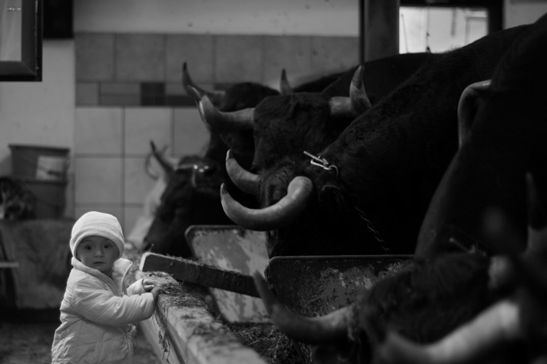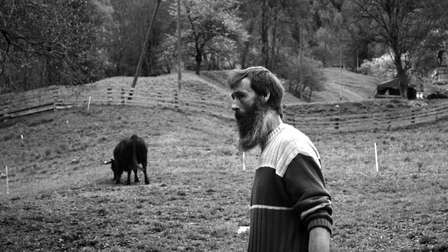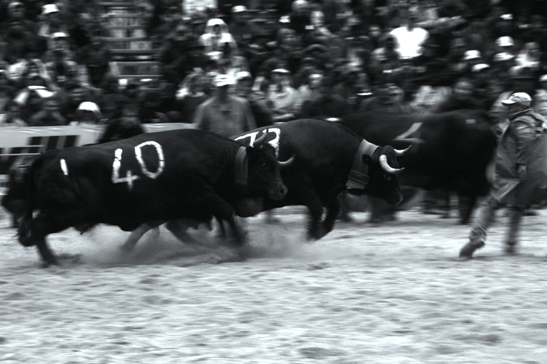
Centred on a cow-fighting event in Switzerland, the film has been lauded almost entirely on the strength of its undeniably beautiful cinematography. Yet to focus on this one aspect is to do the film a severe injustice.
Like many great documentaries, it takes a different approach to documentary as a form, pushing some boundaries, without losing sight of the conventions we all know and love. Do not expect a quirky character piece, or indeed a piece of activist cinema. Similarly, don’t expect to see a requiem for local traditions or a scathing attack on global capitalism. Don’t even expect to be offered much in the way of tangible information about cow fighting itself, or even the people who constitute the film’s primary focus. So if these are all the things it isn’t, what exactly is it?
To summarise in one handy turn of phrase is tricky, but essentially Battle of the Queens is a celebration of the here and now, a celebration of a tradition that, while it may have its roots in the past, is very much a facet of the modern world; as contemporary as Facebook and ready meals.
One could justifiably comment on the juxtaposition of old and new (the film’s opening shot, for instance, features men in Lederhosen blowing Alpen Horns underneath an array of banners pasted with all manner of corporate logos), or even the multi-generational subject demographic. Yet because of the primarily non-judgemental stance the film takes, such distinctions become meaningless. Past, present and future co-exist, working within the same parameters and towards the same aims, achieving a unity rarely seen in these progress driven times to which we belong.
This refusal to make the charge of anachronism is one of the great strengths of the documentary, and one that sets it apart immediately from a great deal of filmic laments that document the outdated, outmoded and deceased. As a result, what we are offered is a vibrant, lively documentary, with an infectiously upbeat dynamic that optimistically tips its hat to the positives in life, without falling prey to naiveté or compromising its message.
At the heart of this, and somewhat surprisingly—at least to our bourgeois, post-1960s, Western sensibility—is a lack of any ideological statement with regards to the debatably dubious animal rights issues depicted. On the contrary, the animals, and the battles in which they engage, are the very lifeblood of the film and the community it depicts. As one man points out, the welfare of the cows is in fact the most important consideration.
The awe-inspiring use of slow-motion in one particularly sublime ‘battle’ sequence reflects the reverence these people hold for the cows. The use of music and sound contribute immeasurably: meditative, almost tribal, music lulls us into a trance-like euphoria, while the temporal discrepancy between sound and image elevates them above the realms of the physical world, and, indeed, beyond our everyday, earthly perception of time and space.

Yet an earthly, and ultimately human, space it is. If the cows are the sun in this bovine solar system, then the spectators, handlers and wranglers are its planets; the infants, mothers and elderly parents left at home the satellites; all united by a single irresistible force that binds them together. This is a textbook representation of community, yet one that entirely ignores the rulebook.
Without much effort it is easy to figure out in what order the director sourced each of his subjects—and indeed the role he most probably played in bringing a number of them together—but the delicate structure of the film subtly distracts our attention from such manipulation and instead sets our hearts aflame with a portrait of chance encounters, burgeoning friendships and age-old family ties.
On an individual level, Steiner wholeheartedly resists the temptation to explain away the motivations of the people he examines (the marked exception being the adolescent boy chasing Deborah, the attractive young cow girl; his motivations are plain enough to see). By stripping exposition and exposé to their barest bones, he retains the ambiguity of man’s psyche and allows us to experience what he surely experienced in the production process: fleeting encounters with the fears, dreams and passions of other souls, that defy comprehension, yet provoke in us the age-old, unquenchable fascination we hold for our fellow beings.
Within such a context, simple, touching statements, such as ‘My cow is doing well, my mum is doing well, I’m good’ take on an almost existential sheen, causing us to reflect on the nature of our own lives and those around us. The ‘wrangler’s tale’—of a man who never pays for the rounds of drinks he always promises, until one day he is caught out, and forced to pay to the amusement of his friends and acquaintances—would not seem out of place in a Dostoyevsky novel.
Arguably one of the vital elements in achieving this mode of expression is the fact that the film crew manages to remain largely invisible, with only the curious eyes of a young child, a cautionary word from a bearded cow-farmer and a brief monologue by an enthusiastic radio presenter any clue that his subjects are aware of the presence of the camera. Such a technique creates a veil of objectivity, minimising the audience’s awareness of any, frankly inevitable, ‘performance’ and thus painting a wholly convincing snapshot of reality in spite of the indulgent—albeit entirely justified—stylisation.
Which, incidentally, brings me neatly onto my final point. Despite my earlier comment, it is indeed very difficult to discuss this film without a closer look at the sterling work of cinematographer Markus Nestroy: never anything less than equal to the world he seeks to depict, he displays a surprising maturity of style for an unknown such as himself. The compositions are bold, the camera movement sensitive and the aforementioned use of slow-motion never contrived or misplaced, although the line he treads is a fine one.

The crystalline black and white is entirely appropriate, accompanied by a confident, deftly employed use of both deep and soft focus, endowing the entire body of the film with an otherworldy—as opposed to ‘olde-worlde’—ethereal aesthetic that ties in exquisitely with the pace and ambience of the piece as a whole. On top of all this he also appears to have what one might refer to as ‘balls’, often filming in close proximity to some rather large, unrestrained cows, without so much as a wobble of the camera. Talented and bold? Definitely one to watch for the future.
Unfortunately such a future may be reliant on factors apart from the obvious talent on display here. Battle of the Queens is currently without a distribution deal, a fact that is nothing short of criminal. This is a film that should be enjoyed on a wider platform, not solely within the confines of a select number of film festivals scattered throughout Europe. It is films such as this that lay bare some of the major problems in the structure of distribution networks in the present day film industry.
All we can hope is that it can find some form of channel for release (if not theatrical, then at least on DVD), and can therefore achieve its potential by reaching, possibly not the general public, but certainly the attention of the film community in its broadest sense.
If you’d like any further information, email Minicine at minicine@live.co.uk or follow them on Twitter at @MinicineYorks.
This post has been amended to remove the reference to Marseilles International Festival of Documentary 2011. Battle of the Queens did not screen at FID Marseille, but at Berlinale 2011.